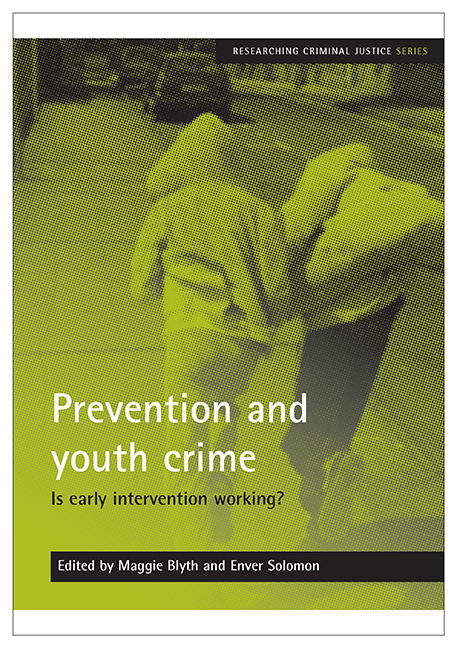Book contents
- Frontmatter
- Contents
- Foreword
- Acknowledgements
- List of abbreviations
- Notes on contributors
- Introduction
- 1 Integrated or targeted youth support services: an essay on ‘prevention’
- 2 Intervening in gang-affected neighbourhoods
- 3 Family intervention projects and the efficacy of parenting interventions
- 4 Early intervention and prevention: lessons from the Sure Start programme
- 5 Attachment research and the origins of violence: a story of damaged brains and damaged minds
- 6 Early intervention in the youth justice sphere: a knowledge-based critique
- 7 European perspectives on prevention
- Conclusion
2 - Intervening in gang-affected neighbourhoods
Published online by Cambridge University Press: 25 March 2023
- Frontmatter
- Contents
- Foreword
- Acknowledgements
- List of abbreviations
- Notes on contributors
- Introduction
- 1 Integrated or targeted youth support services: an essay on ‘prevention’
- 2 Intervening in gang-affected neighbourhoods
- 3 Family intervention projects and the efficacy of parenting interventions
- 4 Early intervention and prevention: lessons from the Sure Start programme
- 5 Attachment research and the origins of violence: a story of damaged brains and damaged minds
- 6 Early intervention in the youth justice sphere: a knowledge-based critique
- 7 European perspectives on prevention
- Conclusion
Summary
Introduction
Violent youth gangs are almost invariably located in economically distressed urban neighbourhoods. Innumerable US studies and recent experience in Europe and the UK mainland indicate that poor housing, material poverty and the absence of primary sector employment contribute significantly to the presence of violent youth gangs (Hagedorn, 1998; Sassen, 2007; Pitts, 2008). This suggests that neighbourhood-level interventions that endeavour to address both the problems afflicting these neighbourhoods and their broader socioeconomic and cultural determinants might serve to stem the flow of young people becoming involved in gang violence as victims and as perpetrators.
Why here? Why now?
From 1979, the post-war tendency towards a narrowing of the gap between rich and poor was reversed, resulting in the growth of both absolute and relative poverty. This income polarisation was mirrored in the housing market. The Right to Buy and Tenant Incentive schemes precipitated a ‘secession of the successful’ as the economically active vacated ‘social housing’ to be replaced by the socially disadvantaged (Hope and Foster, 1992). Whereas at the beginning of the 1980s the average household income of council house residents was 73% of the national average, at the beginning of the 1990s this had fallen to 48%. By 1995, over 50% of these households had no breadwinner (Power and Tunstall, 1995). By 1997, 25% of the children and young people under 16 years old in the UK were living in these neighbourhoods. In its report, Bringing Britain together (SEU, 1998), the Social Exclusion Unit identified 1,370 housing estates in Britain, which it characterised as ‘poor neighbourhoods which have poverty, unemployment, and poor health in common, and crime usually comes high on any list of residents’ concerns’ (SEU, 1998, p 4).
Poverty
In 2008, in Lambeth, a London borough with one of the highest levels of gang-related violence in the UK, over 40% of children live on or near the poverty line. In 2001, in the Lambeth wards where gang activity was most prevalent, between 47% and 60% of children lived in families eligible for means-tested benefits (Income Support, Job Seeker's Allowance, Family Credit and Disability Working Allowance) (Pitts, 2008). The poorest ward in the borough is the stamping ground of the notorious PDC (Peel Dem Crew/Poverty Driven Children).
- Type
- Chapter
- Information
- Prevention and Youth CrimeIs Early Intervention Working?, pp. 21 - 40Publisher: Bristol University PressPrint publication year: 2008

